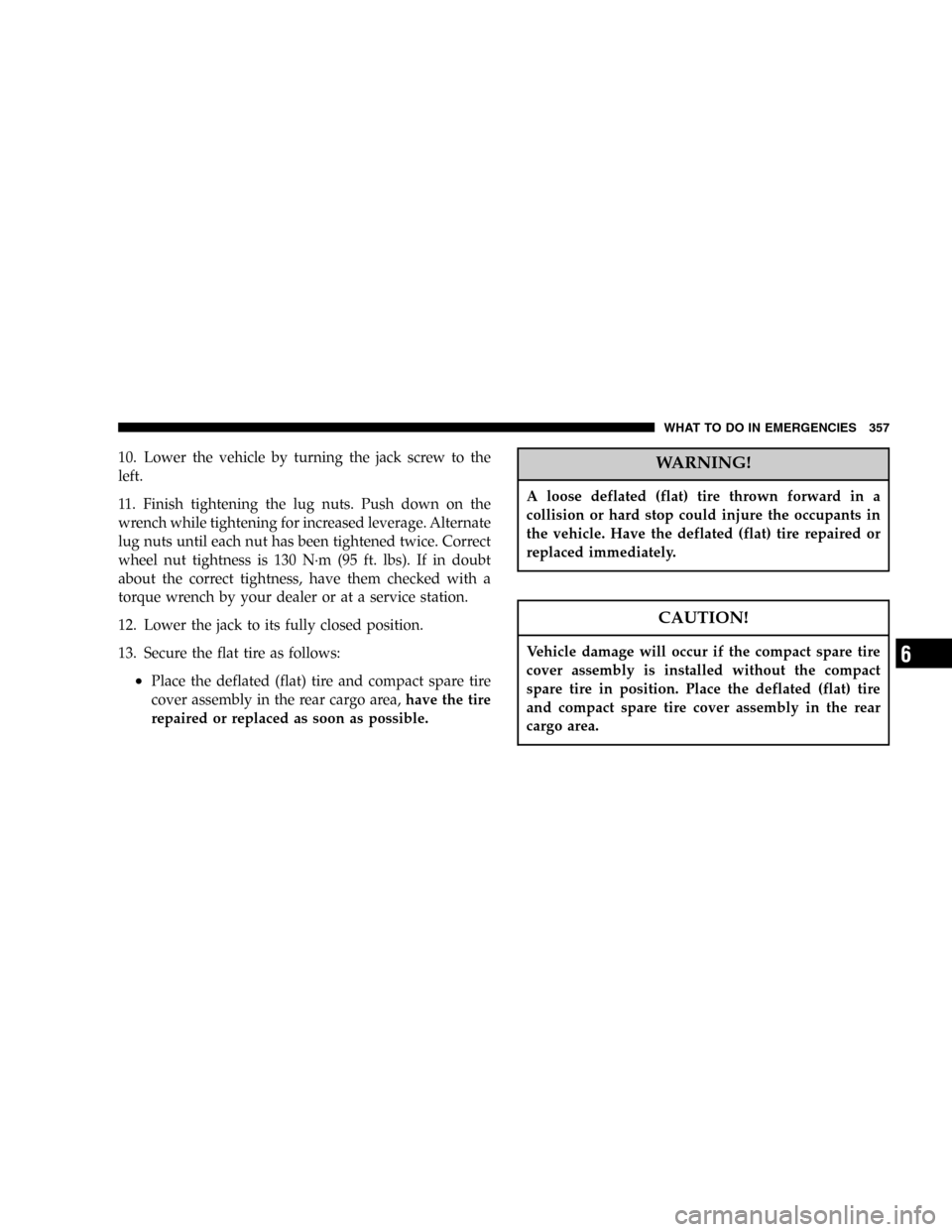Page 320 of 472

check tire pressure. Do not make a visual judgement
when determining proper inflation. Radial tires may look
properly inflated even when they are underinflated.
CAUTION!
After inspecting or adjusting the tire pressure al-
ways reinstall the valve stem cap–if equipped. This
will prevent moisture and dirt from entering the
valve stem, which could damage the valve stem.
Inflation pressures specified on the placard are always
“cold tire inflation pressure”. Cold tire inflation pressure
is defined as the tire pressure after the vehicle has not
been driven for at least 3 hours, or driven less than 1mile
(1 km) after a 3 hour period. The cold tire inflation
pressure must not exceed the maximum inflation pres-
sure molded into the tire side wall.Check tire pressures more often if subject to a wide range
of outdoor temperatures, as tire pressures vary with
temperature changes.
Tire pressures change by approximately 1 psi (7 kPa) per
12°F(7°C) of air temperature change. Keep this in mind
when checking tire pressure inside a garage especially in
the winter.
Example: If garage temperature = 68°F (20°C) and the
outside temperature = 32°F(0°C) then the cold tire
inflation pressure should be increased by 3 psi (21 kPa),
which equals 1 psi (7 kPa) for every 12°F(7°C) for this
outside temperature condition.
Tire pressure may increase from 2 to 6 psi (13 to 40 kPa)
during operation. DO NOT reduce this normal pressure
build up or your tire pressure will be too low.
320 STARTING AND OPERATING
Page 321 of 472
Tire Pressures for High Speed Operation
The manufacturer advocates driving at safe speeds
within posted speed limits. Where speed limits or condi-
tions are such that the vehicle can be driven at high
speeds, maintaining correct tire inflation pressure is very
important. Increased tire pressure and reduced vehicle
loading may be required for high speed vehicle opera-
tion. Refer to original equipment or an authorized tire
dealer for recommended safe operating speeds, loading
and cold tire inflation pressures.WARNING!
High speed driving with your vehicle under maxi-
mum load is dangerous. The added strain on your
tires could cause them to fail. You could have a
serious accident. Don’t drive a vehicle loaded to the
maximum capacity at continuous speeds above 75
mph (120 km/h).
STARTING AND OPERATING 321
5
Page 324 of 472

WARNING!
The limited use spare tires are for emergency use
only. Installation of this limited use spare tire affects
vehicle handling. With this tire, do not drive more
than 60 mph (100 km/h). Keep inflated to the cold
tire inflation pressure listed on either your tire
placard or limited use spare tire and wheel assembly.
Replace (or repair) the original tire at the first
opportunity and reinstall it on your vehicle. Failure
to do so could result in loss of vehicle control.
Tire Spinning
When stuck in mud, sand, snow, or ice conditions, do not
spin your vehicle’s wheels above 35 mph (55 km/h).
See the paragraph on Freeing A Stuck Vehicle in Section
6 of this manual.
WARNING!
Fast spinning tires can be dangerous. Forces gener-
ated by excessive wheel speeds may cause tire dam-
age or failure. A tire could explode and injure
someone. Do not spin your vehicle’s wheels faster
than 35 mph (55 km/h) when you are stuck. And
don’t let anyone near a spinning wheel, no matter
what the speed.
Tread Wear Indicators
Tread wear indicators are in the original equipment tires
to help you in determining when your tires should be
replaced.
324 STARTING AND OPERATING
Page 325 of 472

These indicators are molded into the bottom of the tread
grooves and will appear as bands when the tread depth
becomes 1/16 inch (2 mm). When the indicators appear
in 2 or more adjacent grooves, the tire should be replaced.
Many states have laws requiring tire replacement at this
point.
Replacement Tires
The tires on your new vehicle provide a balance of many
characteristics. They should be inspected regularly for
wear and correct cold tire inflation pressure. The manu-
facturer strongly recommends that you use tires equiva-
lent to the originals in size, quality and performance
when replacement is needed (see the paragraph on tread
wear indicators). Refer to the Tire and Loading Informa-
tion placard for the size designation of your tire. The
service description and load identification will be found
on the original equipment tire. Failure to use equivalent
replacement tires may adversely affect the safety, han-
dling, and ride of your vehicle. We recommend that you
contact your original equipment or an authorized tire
dealer with any questions you may have on tire specifi-
cations or capability.
STARTING AND OPERATING 325
5
Page 327 of 472

Improper alignment will not cause vehicle vibration.
Vibration may be a result of tire and wheel out-of-
balance. Proper balancing will reduce vibration and
avoid tire cupping and spotty wear.
TIRE PRESSURE MONITOR SYSTEM—IF
EQUIPPED
The Tire Pressure Monitor System (TPM) system uses
wireless technology with wheel rim mounted electronic
sensors to monitor tire pressure levels (EXCLUDING
THE SPARE TIRE). Sensors, mounted to each wheel as
part of the valve stem, transmit tire pressure readings to
a receiver located in the instrument panel.
NOTE:The tire pressure monitoring system on your
vehicle will warn you when one of your tires is signifi-
cantly underinflated and when some combinations of
your tires are significantly underinflated. It is particularly
important, therefore, for you to check the tire pressure in
all of your tires regularly and maintain proper pressure.
1,2,3, OR 4 TIRE(S) LOW PRESSURE
Low tire pressure levels of 28 psi [1.9 bars] (193 kPa) or
less detected in one or more tires.
Inspect all tires for proper inflation pressure, once proper
tire pressure has been set the TPM system warning will
reset automatically once ignition switch has been turned
ON.
1,2,3, OR 4 TIRE(S) HIGH PRESSURE
High tire pressure levels of 48 psi [3.3 bars] (330 kPa) or
more detected in one or more tires.
Inspect all tires for proper inflation pressure, once proper
tire pressure has been set the TPM system warning will
reset automatically once ignition switch has been turned
ON.
STARTING AND OPERATING 327
5
Page 345 of 472
WHAT TO DO IN EMERGENCIES
CONTENTS
�Hazard Warning Flasher..................346
�If Your Engine Overheats.................347
�Jacking And Tire Changing................348
▫Jacking Instructions—Fold-In-Floor Seating . . 349
▫Jacking Instructions—Non Fold-In-Floor
Seating.............................361
�Jump-Starting Procedures If Battery Is Low....367
�Driving On Slippery Surfaces..............369
▫Acceleration.........................369▫Traction............................369
�Freeing A Stuck Vehicle..................370
�Towing A Disabled Vehicle................371
▫With Ignition Key.....................371
▫Without The Ignition Key...............372
▫Towing This Vehicle Behind Another Vehicle
(Flat Towing With All Four Wheels On The
Ground)............................372
▫Towing This Vehicle Behind Another Vehicle With
A Tow Dolley........................372
6
Page 354 of 472
NOTE:If either front tire is flat, it may be necessary to
jack up the vehicle to remove the compact spare tire/
cover assembly from under the vehicle. Refer to jack
engagement locations in the following steps for proper
jack placement.4. When the compact spare tire/cover assembly is clear
of the vehicle, stand the tire/cover assembly upright and
remove the wheel spacer by squeezing the two retaining
tabs together.
5. There are two jack engagement locations on each side
of the body, refer to the following illustration.
Spare Tire/Cover Removal
Wheel Spacer Removal
354 WHAT TO DO IN EMERGENCIES
Page 357 of 472

10. Lower the vehicle by turning the jack screw to the
left.
11. Finish tightening the lug nuts. Push down on the
wrench while tightening for increased leverage. Alternate
lug nuts until each nut has been tightened twice. Correct
wheel nut tightness is 130 N·m (95 ft. lbs). If in doubt
about the correct tightness, have them checked with a
torque wrench by your dealer or at a service station.
12. Lower the jack to its fully closed position.
13. Secure the flat tire as follows:
•Place the deflated (flat) tire and compact spare tire
cover assembly in the rear cargo area,have the tire
repaired or replaced as soon as possible.
WARNING!
A loose deflated (flat) tire thrown forward in a
collision or hard stop could injure the occupants in
the vehicle. Have the deflated (flat) tire repaired or
replaced immediately.
CAUTION!
Vehicle damage will occur if the compact spare tire
cover assembly is installed without the compact
spare tire in position. Place the deflated (flat) tire
and compact spare tire cover assembly in the rear
cargo area.
WHAT TO DO IN EMERGENCIES 357
6